August 10, 2011
August 10, 2011 (Latin America Data Byte)
By Rebecca Ray
En Español
Both mining and non-petroleum manufacturing slowed to less than half of their growth rate from the previous quarter.
Ecuador’s GDP rose at an annualized rate of 7.3 percent in the first quarter, as compared to the fourth quarter of last year. This is slower than the 11.0 percent growth in the fourth quarter of 2011. Although first-quarter growth was still rapid, it saw the first decline in the growth rate in a year. Over the last four quarters, GDP has growth by 7.6 percent, bringing it to 7.8 percent above its pre-recession peak of 2008.
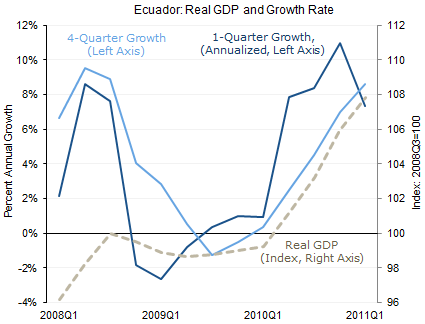
Source: Central Bank of Ecuador
Growth was driven mostly by construction, which added 3.2 percentage points to overall annualized GDP growth, and “other services” (restaurants, bars, hotels, communications, rental housing, business and household services, education, and health), which added 2.4 percentage points. Together, these two sectors were responsible for over three-quarters of GDP growth in the first quarter. Only the public administration sector (including defense and social security) had a negative impact on GDP. Without the fall in this sector, annualized GDP growth would have been 0.6 percentage points higher.
Source: Central Bank of Ecuador
Note: Manufacturing includes petroleum-product manufacturing here, and the “other services” category includes restaurants, bars, hotels, communications, rental housing, business and household services, education, and health.
Among just industrial (goods-producing) sectors, construction has grown much more quickly than any other, more than three times the rate of growth in the economy as a whole since the recession. Construction has had cumulative growth of 17.5 percent since the first quarter of 2010, and doubled that growth rate in the most recent quarter, accelerating to an annualized rate of 36.6 percent and rising to 24 percent above its pre-recession peak of 2008. Industrial sectors overall have had cumulative growth of 10.2 percent since the first quarter of 2010, and continued that pattern in the first quarter of 2011 with annualized growth of 10.7 percent, rising to 7.7 percent above their pre-recession peak.
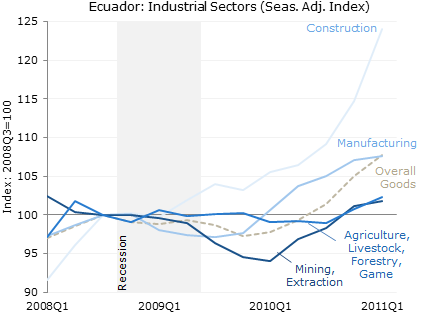
Source: Central Bank of Ecuador
Of the other major industrial sectors, non-petroleum manufacturing has grown about the same as industry in general, while agriculture and mining have underperformed other industrial sectors. Non-petroleum manufacturing grew at only a 2.2 percent annualized rate in the first quarter of 2011, reaching 7.6 percent above its 2008. Agriculture has grown 3.3 percent since the first quarter of 2010 and accelerated to 6.5 percent annualized growth during the most recent quarter, but has achieved only a 2.3 percent increase from its 2003 level. Mining, which shrank more than any other major industrial sector during and after the recession, has grown 8.3 percent over the last four quarters but slowed to an annualized 2.8 percent growth rate in the first quarter of 2011 and reached only 1.8 percent above its 2008 level.
Among service sectors, the fastest growing has been the category of “other services,” which as mentioned above includes restaurants, bars, hotels, communications, rental housing, business and household services, education, and health. It has grown 11.7 percent over the last four quarters, and accelerated to a 15.2 percent annualized rate in the most recent quarter, reaching 14.7 percent above its 2008 level – nearly twice as much growth as the economy as a whole. Meanwhile, public administration shrank at a 12.3 percent annualized rate in the first quarter, bringing its growth over the last four quarters to just 0.03 percent. After growing more quickly than the overall economy prior to and during the recession, it has slowed, averaging just 0.2 percent annual growth over the last two years.

Source: Central Bank of Ecuador
Service sectors overall have grown 7.2 percent over the last four quarters, and in the first quarter of 2011 grew at an annualized rate of 6.8 percent, reaching 8.9 percent above their 2008 levels. Among the remaining major service sectors, logistics (transportation and warehousing) has performed about as well as the service sectors overall, while commerce has grown somewhat less. Logistics grew at an 8.4 percent annualized rate in the most recent quarter and 4.7 percent over the last four quarters, rising to 8.4 percent above its pre-recession peak in the most recent quarter, just 0.5 percentage points below the service sector as a whole. Commerce fell by more than any other service sector during the recession, but has since grown to 5.6 percent above its pre-recession peak, having grown 6.3 percent over the last four quarters and 3.1 percent annualized in the most recent quarter.
Seen over a longer period of time, construction and public administration both grew more quickly than the overall economy over the last business cycle, but after the most recent recession, construction regained its previous growth while public administration slowed.
Source: Central Bank of Ecuador
Among expense types, GDP growth was spurred by growth in gross fixed capital formation and private consumption, which added 5.8 and 2.3 percentage points to annualized GDP growth, respectively, and by an improving trade balance, which added 7.1 percentage points. Meanwhile, government consumption took away 0.6 percentage points from GDP growth, and inventory changes took away an additional 7.2 percentage points.
Source: Central Bank of Ecuador
Looking more closely at the individual components, gross fixed capital formation has grown more quickly than any other non-trade expenditure. It has grown 16.7 percent over the last four quarters, and accelerated to a 20.3 percent annualized growth rate in the most recent quarter, ending at 12.3 percent above its 2008 level. Government consumption, like the public administration sector above, fell in the first quarter of 2011, at an annualized rate of 5.8 percent, bringing its four-quarter growth rate down to 2.7 percent. Private consumption has also grown more quickly than the overall economy since the recession, but in the first quarter of 2011 it slowed to an annualized of 3.2 percent growth. Over the last four quarters it has grown 7.6 percent, and is currently at 9.5 percent above its pre-recession level.
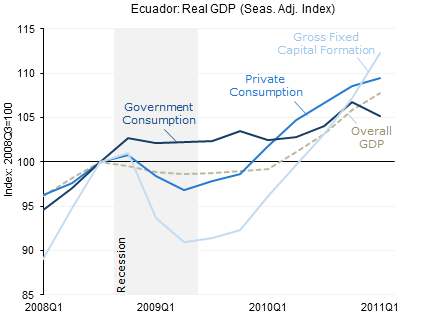
Source: Central Bank of Ecuador
Finally, the trade deficit shrank for the second consecutive quarter, from $910 million in the third quarter of 2010 to $734 million USD in the most recent quarter. Exports rose at an 8.7 percent annualized rate, having risen for three out of the last four quarters. Imports shrank at an annualized rate of 7.8 percent, but over the last four quarters they have still grown by 8.0 percent.
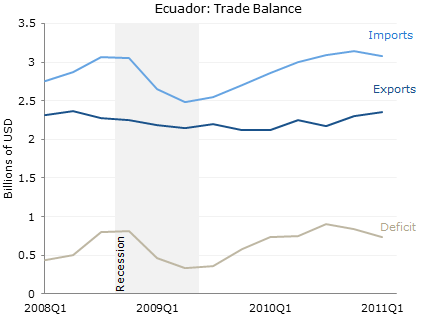
Source: Central Bank of Ecuador
It is noteworthy that this is the first time imports have fallen since the recession. It is also only the second time in the last eight years that imports have fallen outside of a recession.
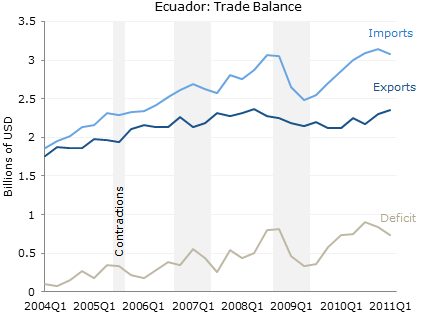
Source: Central Bank of Ecuador
In sum, Ecuador’s economy is continuing its expansion, with only one sector and one major expenditure type pulling growth down: government spending. Meanwhile, construction and investment have seen several quarters of double-digit growth. It will bear watching whether inventories and imports rebound in future quarters.





